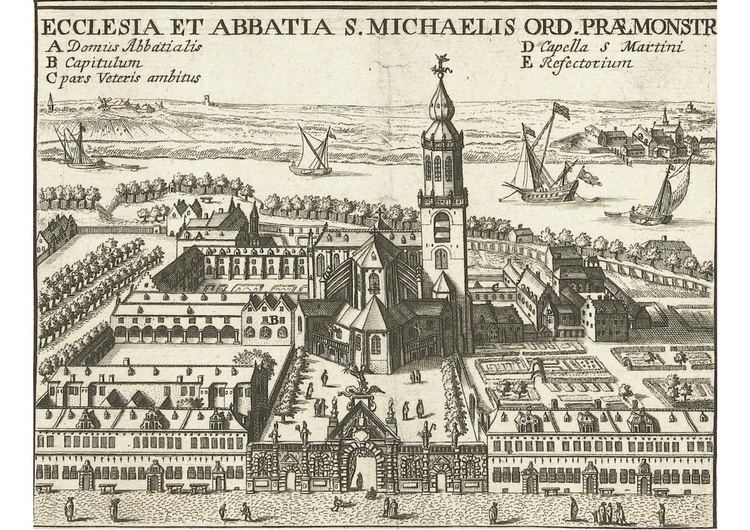Order Premonstratensian Functional Status demolished 1831 Disestablished 1795 | Status suppressed 1795 | |
 | ||
Other names Abbatia Sancti Michaelis Antverpiae | ||
St Michael's Abbey in Antwerp was a Premonstratensian abbey founded in 1124 by Norbert of Xanten and laid waste during the French Revolutionary Wars. In 1807 a semaphore station was installed in the tower of the church. The buildings were demolished in 1831.
Contents
The abbey has been described as "one of the key churches and most significant monuments in Antwerp from its foundation in the 12th century to its destruction in the nineteenth."
History
Until 1124 a collegiate church dedicated to Saint Michael and served by 12 secular canons was the only parish church in Antwerp. In 1124 the chapter was reformed by St Norbert as a Premonstratensian abbey. The abbey buildings stood between what are now the streets Kloosterstraat and Sint-Michielskaai, and Sint-Jansvliet in the north and the Scheldestraat (Kronenbrugstraat) in the south.
The abbey obtained large tracts of land in and around Antwerp, such as the lordships of Kiel and Beerschot, the land of Haringrode and Zurenborg and as late as 1674 Berendrecht and Zandvliet, which helped shape the ultimate territory of Antwerp.
The abbey was partly destroyed by the French army during the War of the First Coalition in 1796. Many of the buildings were demolished to create military barracks and a naval arsenal with shipyards and slipways. In 1807 the tower of the abbey church was equipped with a semaphore. In 1831 the French barracks were bombarded by the Dutch garrison Commander David Hendrik Chassé, whose troops were holding the Citadel of Antwerp.
Art
Isabella of Bourbon (1436-1465), second wife of Charles the Bold, Duke of Burgundy, and the mother of Mary of Burgundy, heiress of Burgundy, died in the abbey in 1465 and was buried in the abbey church. In 1476 a monumental tomb was erected in her memory. It was decorated with 24 bronze statuettes of Pleurants standing in niches, known as 'weepers' or 'mourners', with a bronze effigy of Isabella herself surmounted on it. The remnants of the pleurants are now kept in the Rijksmuseum (Amsterdam) and in M - Museum Leuven. The rest of the tomb, with the statue of Isabella, is now in Antwerp Cathedral. Nothing more of the tomb furnishings survives.
In the 17th century the monastery was well known as a patron of the arts, commissioning works from major Antwerp painters such as Peter Paul Rubens, Anthony van Dyck and Jacob Jordaens. Around 1624 Rubens delivered a monumental altarpiece for the abbey church, The Adoration of the Magi. It was stolen during the French occupation and after 1815 was returned to the Royal Museum of Fine Arts (Antwerp).
The floor with many tombstones was transferred to the Cathedral of Our Lady, that had lost its floor during the French occupation.
The 18th century communion bench and the confessional are now in the Church of St Gertrude in Bergen op Zoom (Netherlands).
Abbots
A list of abbots to 1709:
Burials
In the church lots of important people were burried.
